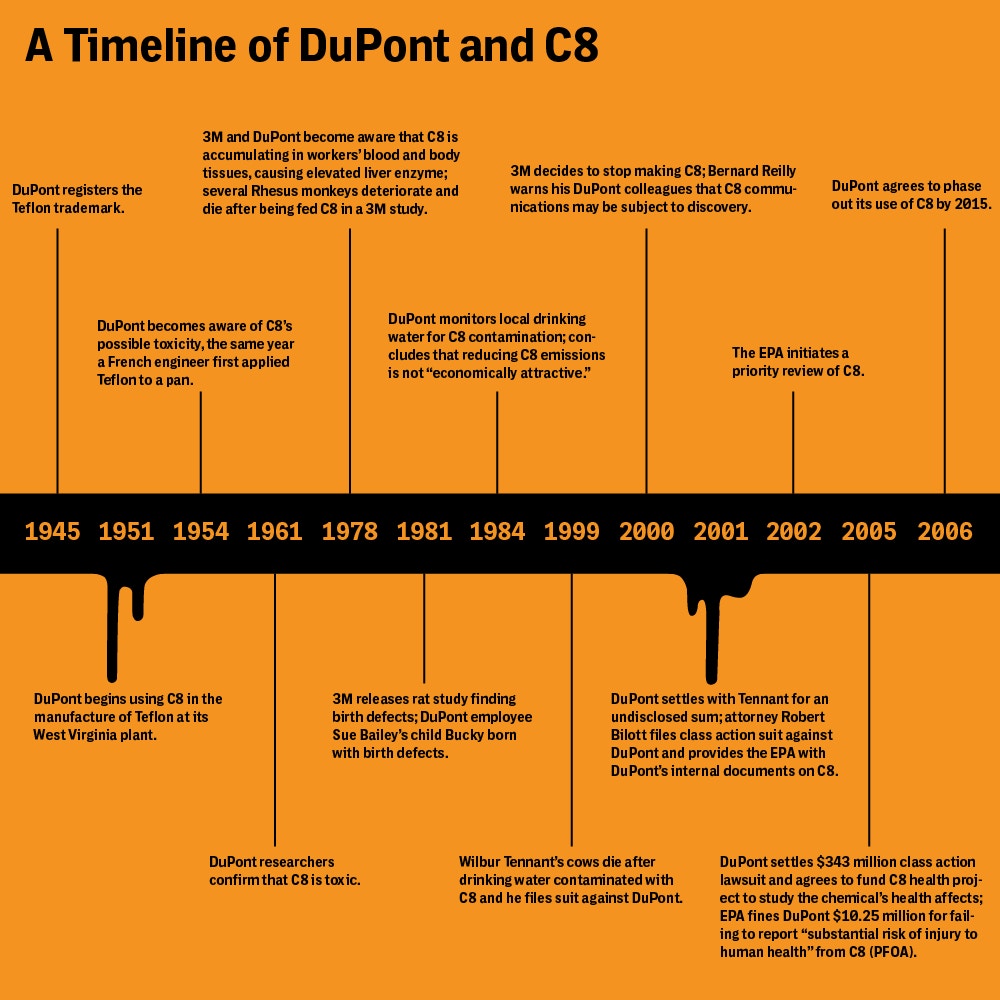Part 3 – The Impact of Public Awareness
I once heard someone say that turning on your faucet is the biggest act of blind faith you can imagine. We as consumers tend to know very little about the contents of our drinking water and simply assume that it is safe unless told otherwise. Perfluorinated compounds, like those used in the production of Teflon and other non-stick, water-resistant, and grease-resistant products have shown up in drinking water all over the country (not just near DuPont plants) and in materials in every country on the planet. Through constant exposure from multiple sources, it is in our blood.
As with the previous two installments of this post, I am writing before the movie “Dark Waters”[1] has even been released. I hope a lot of the content below will be showcased in the film, but I don’t know. The only spoilers you’ll find here are publicly-available facts from news articles, court cases, and documentaries (specifically “The Devil We Know,”[2] unless otherwise noted).
Public Action
When we last left our heroes, Parkersburg resident Joe Kiger was teaming up with attorney (and “Dark Waters” protagonist) Rob Bilott on a class action lawsuit against DuPont. Joe had been doing research into the issue around drinking water safety after receiving a letter from his local water authority that included a disclosure about C8 content. He did some more digging and received information about Wilbur Tennant’s case from the EPA. He connected the dots between Tennant’s herd, anecdotes from his neighbors, and information from his water authority before reaching out to Rob Bilott wanting to get help for his community.

It was a noble action on Joe’s part, but in 2001 as he took on the role of lead plaintiff in the case on behalf of 6 different water districts, there was a lot of resistance in the community from people who were worried about losing their jobs. DuPont had provided a lot of support for the community over the years through education and enrichment; they had built a lot of goodwill with their stakeholders through a strong public relations campaign. Former DuPont workers interviewed in the documentary believed that DuPont would not knowingly put them in harm’s way.
In 2005 DuPont agreed to settle out of court, with Ohio River Valley residents receiving a total payout of $343 million dollars. However, instead of simply taking their shares of the money, the plaintiffs decided to set up a science panel to investigate the health impacts of DuPont’s chemical compounds. If a connection was found, residents of the six water districts would be able to sue DuPont directly for injury; if no connection was found, residents would waive all future rights of suing DuPont over a connection to health problems from C8.
Scientific Findings
The process took seven years, and 70,000 people participated in sharing their blood for testing. It was the largest human health study in the history of the world with the most scientific focus on a single pollutant. The results came back in 2012 confirming a link between C8 in the drinking water and six different diseases: kidney cancer, testicular cancer, ulcerative colitis, thyroid disease, preeclampsia, and high cholesterol. Based on the parameters of the settlement, anyone in the six water districts with any of those diseases could sue DuPont for personal injury. Over 3,500 individuals filed suits.

In part one of this series, I mentioned a woman who was interviewed in “The Devil We Know” about her son, who was born with severe birth defects after she worked on the C8 production line. She was unable to file suit against the company following the scientific study because birth defects were not among the confirmed outcomes of C8 exposure. According to the study, the sample set was too small to draw a connection: two cases of birth defects among eight pregnant women working with the C8, while a high percentage, did not represent a statistically-valid sample.
Fallout
In addition to the personal injury suits that DuPont faced, the EPA fined the company $16.5 million for failing to report health risks from exposure. (It should be noted that for a company doing $20-25 billion annually in revenue, $16.5 million was not exactly a significant number.) In 2012 the EPA published health advisories about PFOA and PFOS, and they began requiring public water authorities to monitor for the compounds, but there are still no federal drinking water standards in place.[5]
After the lawsuit, DuPont agreed to participate in a gradual phase-out of C8, leading up to 2015, after which no one could produce it. While this is a good turn of events, it is hardly a Hollywood ending. There are still materials that contain PFOA, even though it is no longer manufactured, as I learned last spring when researching one of my first blog posts on fast food packaging.[6]

Also, while DuPont has stopped making C8, it has replaced that compound with a new one called “Gen-X” [insert jokes here]. Gen-X serves the same role in the production process that C8 did, raising the question of whether or not this new, untested compound is any better. The problem is that without robust testing, no one can draw a connection between Gen-X and health concerns in humans. Initial lab studies have shown similar impacts in rats as what they experienced with C8, so DuPont’s critics remain understandably skeptical.
“The Devil We Know” closed with the following quote:
Facing thousands of lawsuits, DuPont created a spin-off company called Chemours, which took over all manufacturing of Gen-X. Chemours is now one of the largest producers of fluorochemicals in the world.
Next week in Part 4 we will conclude this subject by talking about actions and alternatives we can take in our everyday lives to limit exposure to potentially unsafe chemical compounds in a variety of common household products.
Thanks for reading!
[1] https://en.wikipedia.org/wiki/Dark_Waters_(2019_film)
[2] https://en.wikipedia.org/wiki/The_Devil_We_Know
[3] https://www.organicconsumers.org/news/lawyer-who-became-duponts-worst-nightmare
[4] https://theintercept.com/2015/08/20/teflon-toxin-dupont-slipped-past-epa/
[5] https://www.epa.gov/ground-water-and-drinking-water/drinking-water-health-advisories-pfoa-and-pfos
[6] https://radicalmoderate.online/zero-waste-lent-week-1-food/
[7] https://www.masstortnexus.com/mass-torts-news/dupont-and-chemours-agree-to-671-million-settlement-in-teflon-cancer-mdl/
0 Comments